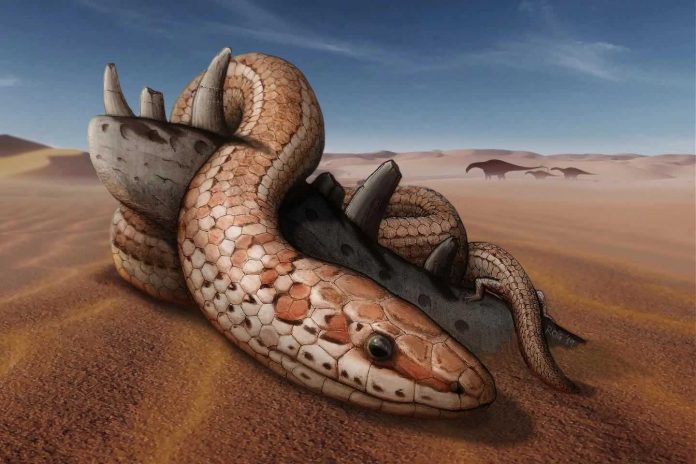A species of ancient snake had hind limbs for around 70 million years before losing them, researchers have discovered. This shows these creatures lived successfully with legs for a very long time before developing the characteristic body shape seen today—adding to the complicated story of snake evolution.
Palaeontologists from Argentina, Canada, Australia and the US say their analysis of three-dimensionally preserved skulls of the Cretaceous legged snake Najash indicates that snakes possessed hindlimbs for about 70 million years before evolving their modern look.
Recently published in the Science Advances journal, snake fossils suggest they actually had back legs for an extended period of time. ‘Najash Rionegrina’ was a type of early snake with back limbs. Researchers uncovered eight fossils, including one that was almost perfectly intact.
Skull analysis revealed that Najash lacked a full crista circumfenestralis, the series of bony crests long considered a defining feature of “snakeness”, but still had a cheekbone – also known as a jugal bone – which has all but disappeared in their modern descendants.
“Our findings support the idea that the ancestors of modern snakes were big-bodied and big-mouthed, instead of small burrowing forms as previously thought,” says lead author Fernando Garberoglio, from the Fundación Azara at Universidad Maimónides, Argentina.
They also revolutionise our understanding of the jugal bone in snake and non-snake lizards, adds co-author Michael Caldwell, from Canada’s University of Alberta.
“After 160 years of getting it wrong, this paper corrects this very important feature based not on guesswork, but on empirical evidence.”
Understanding snake evolution has been hampered by a limited fossil record, so the discovery of eight Najash skulls – one almost perfectly intact – and other fossilised remains was something to celebrate.
Garberoglio and colleagues used micro-computed tomography scanning to visualise the skull structures, examining the pathways of nerves and blood vessels, as well as the skeletal structure that would be otherwise impossible to see without damaging the fossil.
Najash, they say, was closely related to an ancient lineage of snakes that populated the southern hemisphere continents of Gondwana, but appears to be related to only a small number of obscure, modern snakes.
“Najash is now the best-known early snake and substantially clarifies the homologies of several problematic but key elements of the modern snake skull as well as the evolution of the skull from much more ancient snakes and even earlier non-snake lizards,” the authors write.
“These new materials of Najash shed light on the affinities of Late Mesozoic snakes and the successive evolutionary changes that led to the origin of modern snakes and one of the most remarkable vertebrate body plans.”















